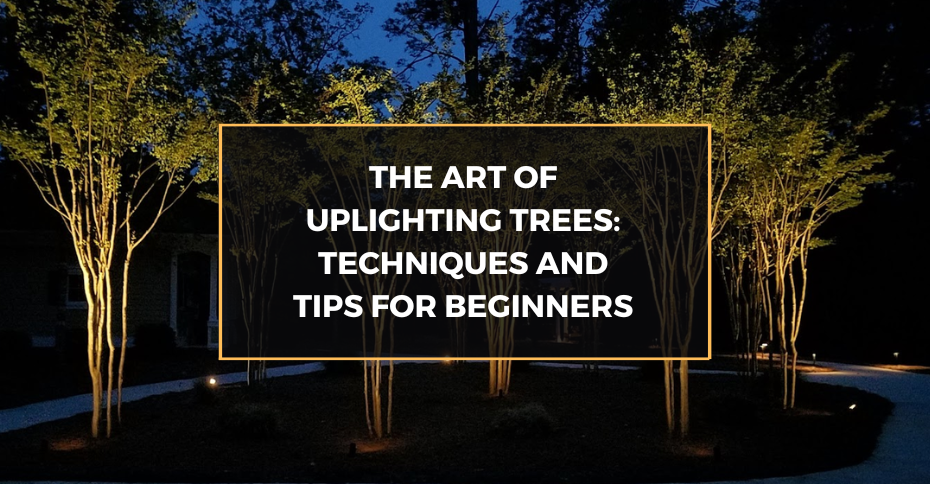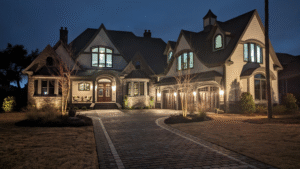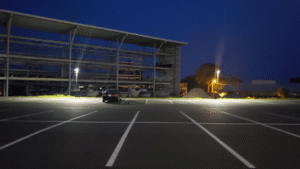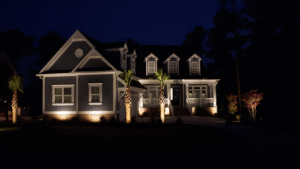Understanding Uplighting
Uplighting trees transforms the nighttime landscape by casting a warm glow on trees and architectural features.
What is Uplighting?
Uplighting is a technique used in landscape lighting that involves placing lights at the ground level to illuminate objects or features from below, creating a dramatic and inviting atmosphere. This method highlights the form and structure of trees, showcasing their branches and foliage in a unique way. By casting shadows and forming silhouettes, uplighting can turn an ordinary garden into an enchanting space. It is essential, however, to understand the balance between light and shadow to avoid over-illumination, which can lead to a flattened perspective and loss of the three-dimensional effect.
Benefits of Uplighting Trees
Uplighting trees not only enhances the aesthetic appeal of a landscape but also increases the safety and security of the area. It extends the hours of enjoyment of your outdoor space, making it perfect for evening gatherings. Additionally, strategically placed lights can accentuate the best features of your garden, adding value to your property. From a practical standpoint, uplighting trees can also guide visitors along pathways and deter potential intruders by eliminating dark areas in your garden.
Choosing the Right Lights
Selecting the right lights for uplighting trees is crucial for achieving the desired effect.
Types of Lights for Uplighting Trees
There are several types of lights that can be used for uplighting trees, including spotlights, in-ground lights, and well lights. Spotlights are versatile and can be adjusted to focus on specific tree features, while in-ground lights provide a more subtle and integrated look. Well lights are recessed into the ground and are ideal for illuminating trees without making the light source obvious. LED lights are a popular choice due to their energy efficiency, long lifespan, and range of color options.
Factors to Consider When Choosing Lights
When selecting lights for uplighting trees, consider the size and height of your trees, the desired intensity of the light, and the overall design of your landscape. The color temperature of the light can also significantly affect the mood of the space; warmer tones create a cozy atmosphere, while cooler tones are ideal for highlighting the natural colors of foliage. Additionally, the durability and weather resistance of the light fixtures are crucial factors, especially in areas with harsh weather conditions.
Positioning Your Lights
The strategic placement of lights is what turns simple illumination into a form of art. It’s not just about where the light is placed, but also about where the shadows fall.
Basic Principles of Light Placement
The placement of lights when uplighting trees is critical in creating the desired effect. As a rule of thumb, lights should be positioned so that they illuminate the trunk and the underside of the canopy. This placement helps in achieving a balanced look that highlights the tree’s structure without causing excessive glare or light pollution. Avoid placing lights too close together or too far apart, as this can create uneven lighting and diminish the overall impact.
Techniques for Different Types of Trees
Different tree species require unique lighting approaches due to their varying shapes, sizes, and foliage densities. For instance, narrow-beam spotlights are ideal for tall, slender trees, as they can highlight the height and form of the tree. In contrast, broader trees with dense foliage may benefit from multiple lights placed at different angles to ensure that the light penetrates through the leaves and illuminates the tree evenly.
Installation Tips
Installing uplighting is more than just sticking lights into the ground. It’s about planning, precision, and safety.
Safety First: Electrical Considerations
Safety is paramount when uplighting trees. Always use outdoor-rated fixtures and bulbs, and ensure that all electrical connections are waterproof and properly insulated. It’s advisable to work with a professional, especially when dealing with complex wiring or installing lights in hard-to-reach areas. Additionally, consider using low-voltage systems, as they are safer and more energy-efficient.
Step-by-Step Installation Process
Begin by planning the layout of your lights and marking the positions. Dig small trenches for the wiring, ensuring that they are deep enough to protect the wires from damage. Install the light fixtures according to the manufacturer’s instructions, then connect the wires to the power source. Finally, adjust the angle and direction of the lights to achieve the desired effect, and fill in the trenches, being careful not to damage the wiring.
The Advantages of Professional Installation
Opting for professional installation can provide peace of mind and ensure that your uplighting system is set up safely and effectively. We bring expertise in electrical systems and landscape design, ensuring that every light is placed for maximum impact while adhering to safety standards. We are equipped to handle unforeseen challenges that may arise during installation, such as dealing with difficult terrain or integrating the system with existing landscape features. Additionally, we offer valuable advice on how to maintain and optimize your lighting system over time. While DIY can be rewarding, the complexity and safety concerns of uplighting installations often make professional services a wise investment.
Achieving the Desired Effect
Achieving the perfect uplighting effect is akin to painting with light; it requires an understanding of how different angles, intensities, and colors interact with the natural environment.
Playing with Angles and Intensity
The angle at which the light hits the tree can dramatically change the visual effect. Experiment with different angles to see which best accentuates the features of your tree. Adjusting the intensity of the light can also play a significant role in setting the mood; softer light creates a more subtle and tranquil ambiance, while brighter light can be used to make a bold statement.
Maintenance and Care
Like any other aspect of landscaping, uplighting requires regular maintenance to keep it looking its best.
Routine Maintenance Tips
Regular maintenance ensures that your uplighting system remains effective and safe. Clean the light fixtures periodically to remove dirt and debris, and check the wiring and connections for signs of wear or damage. Replacing bulbs when necessary and trimming foliage can also help maintain the quality of your lighting.
Troubleshooting Common Issues
Common issues with uplighting systems include burnt-out bulbs, flickering lights, and tripped circuit breakers. Addressing these problems promptly can prevent more significant issues down the line. Familiarize yourself with the troubleshooting guidelines provided by the manufacturer, and don’t hesitate to seek professional help if needed.
FAQs
How do I determine the right number of lights to use for uplighting a single tree?
The number of lights depends on the tree’s size and the density of its foliage. Generally, start with one to two lights for a small or medium-sized tree, and increase the number depending on the tree’s features and the desired intensity.How do I prevent uplighting from attracting insects to my outdoor space?
Use lights with warmer color temperatures, as cooler, bluer light tends to attract more insects. Also, positioning the lights carefully and maintaining a clean area around the light fixtures can help minimize insect attraction.How does uplighting trees affect the growth or health of trees?
If done correctly, uplighting trees should not adversely affect tree health. However, ensure that fixtures are not placed too close to the tree to avoid heat damage, and avoid excessive illumination which can disrupt the tree’s natural growth patterns.Can uplighting trees be incorporated into an existing landscape lighting system?
Yes, uplighting trees can be integrated into an existing system. Consult a professional to ensure that the new lights are compatible with your current setup and to avoid overloading the system.What should I do if my uplighting system stops working correctly?
Check the power source and connections first. If the issue persists, inspect the bulbs and fixtures for damage. If you can’t identify the problem, consult a professional.







